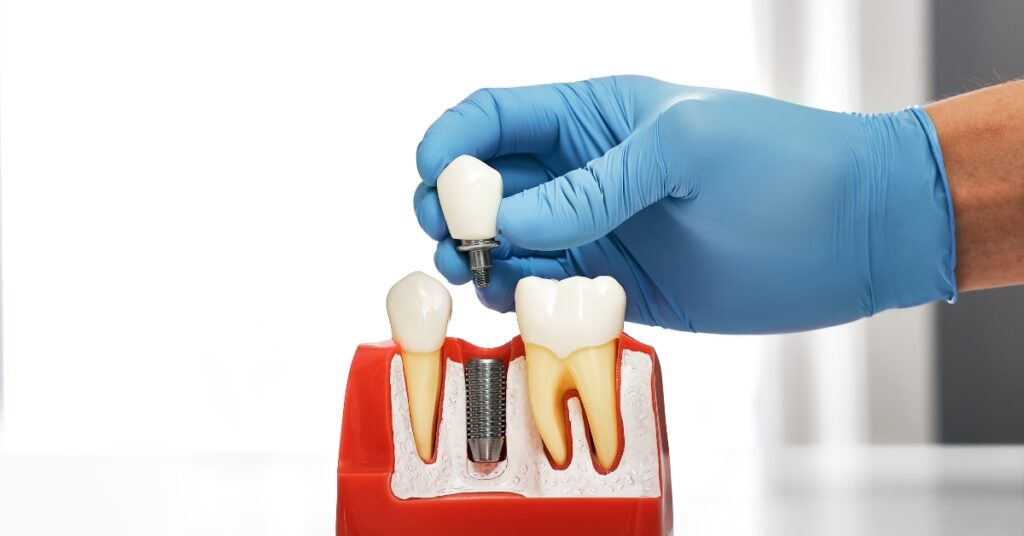Dental implants have revolutionized the field of dentistry, providing a permanent solution to tooth loss that looks and feels natural. They offer numerous benefits, including improved oral health, enhanced appearance, and better functionality. Today, we focus on an innovative type of dental implant that is gaining popularity among dentists and patients alike – the one-piece implant.
In this blog post, we’ll explore what one-piece implants are, their advantages, how to determine if they’re right for your patients and compare them with traditional two-piece implants. By the end, you’ll have a comprehensive understanding of why one-piece implants could be the ideal choice for your practice.

What are One Piece Implants?
One-piece implant is a unique type of dental implant that combines the implant and the abutment into a single unit. This design eliminates the need for a separate abutment, making the implant process more straightforward and efficient.
Simpler Procedure
One of the most significant advantages of one-piece implants is the simpler procedure. Since the implant and abutment are fused, there is no need for additional steps to attach the abutment. This simplification can reduce surgical time and make the overall process more efficient for both the dentist and the patient.
Faster Healing Time
The design of one-piece implants also contributes to faster healing times. With fewer components and no need for multiple surgical stages, patients can experience quicker recovery and reduced discomfort. This can be particularly beneficial for patients who are eager to return to their normal activities as soon as possible.
Potentially Lower Cost
One-piece implants often come with a lower cost compared to traditional two-piece implants. The simplified procedure and reduced need for additional components can result in cost savings that can be passed on to the patient. For dentists, this can also mean reduced overhead and more streamlined inventory management.
Are One Piece Implants Right for Your Patients?
Determining whether one-piece implants are suitable for your patients involves considering several factors. It’s essential to evaluate each patient’s unique dental needs and overall health to ensure the best outcome.
Jawbone Health
A crucial factor in determining candidacy for one-piece implants is the health of the patient’s jawbone. Adequate bone density and volume are necessary to support the implant. Patients with insufficient jawbone may require bone grafting before receiving the implant, which can add complexity and time to the procedure.
Location of Implant
The location of the implant within the mouth can also influence the decision. One-piece implants are typically more suitable for certain positions, such as the front teeth, where the aesthetics and functionality are critical. For areas requiring more substantial support, a two-piece implant may be a better option.
Individual Dental Needs
Each patient has unique dental needs that must be considered when choosing an implant type. Factors such as the patient’s oral hygiene habits, medical history, and specific dental issues play a role in determining the most suitable implant.
One Piece Implants vs. Two Piece Implants
Understanding the differences between one-piece and two-piece implants is essential for making informed decisions. Here’s a comparison of the key aspects:
Procedure Steps
- One Piece Implants: The implant and abutment are placed simultaneously, simplifying the procedure.
- Two Piece Implants: Requires separate placement of the implant and abutment, often necessitating multiple surgical stages.
Healing Time
- One Piece Implants: Generally offer faster healing due to fewer surgical stages and components.
- Two Piece Implants: May require longer healing times due to the need for multiple procedures.
Potential Risks
- One Piece Implants: Reduced risk of bacterial leakage since there is no gap between the implant and abutment.
- Two Piece Implants: Potential for bacterial leakage at the junction between the implant and abutment, which can lead to complications.
Consultation and Procedure
It’s crucial to emphasize the importance of consulting a dentist for personalized advice. A thorough consultation allows for a detailed assessment of the patient’s dental health and specific needs, ensuring the best possible outcome.
The Procedure
The one-piece implant procedure typically involves the following steps:
- Assessment and Planning: A comprehensive evaluation of the patient’s dental health and jawbone condition.
- Implant Placement: The implant is placed in a single surgical stage, with the abutment already integrated.
- Healing Period: Allow time for the implant to integrate with the jawbone, usually a few months.
- Final Restoration: Once healed, a crown or other dental prosthetic is attached to the implant.
Conclusion
One-piece implants offer numerous benefits, including a simpler procedure, faster healing times, and potentially lower costs. They are an excellent option for many patients, particularly those with adequate jawbone health and specific dental needs that align with the advantages of this implant type.
For dentists, incorporating one-piece implants into your practice can streamline procedures, enhance patient satisfaction, and potentially reduce costs. However, it’s essential to conduct a thorough consultation with each patient to determine the most suitable implant option for their unique situation.

